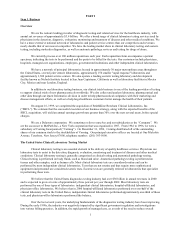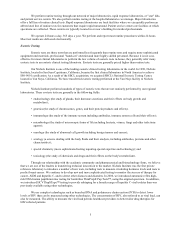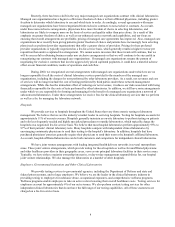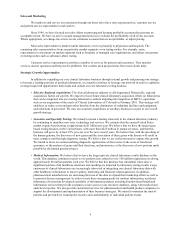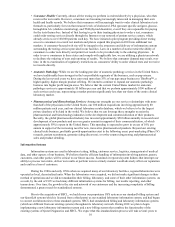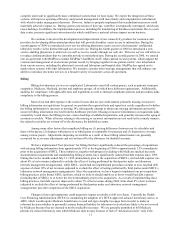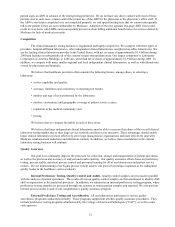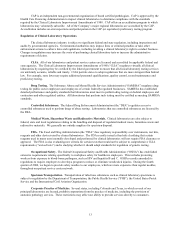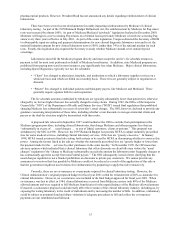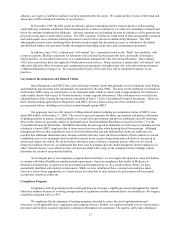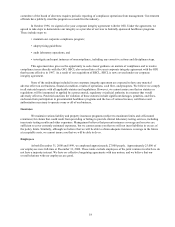Quest Diagnostics 2000 Annual Report Download - page 30
Download and view the complete annual report
Please find page 30 of the 2000 Quest Diagnostics annual report below. You can navigate through the pages in the report by either clicking on the pages listed below, or by using the keyword search tool below to find specific information within the annual report.10
•Consumer Health: Currently, almost all the testing we perform is ordered directly by a physician, who then
receives the test results. However, consumers are becoming increasingly interested in managing their own
health and health records. We believe that consumers will increasingly want to order clinical laboratory tests
themselves, particularly for tests that measure levels of cholesterol, PSA (prostate specific antigen), glucose,
hemoglobin A1c (diabetes monitoring), and TSH (thyroid disorders), even if they are responsible for paying
for the tests themselves. Instead of first having to go to their treating physician to order a test, consumers
could order testing services directly through the Internet or our network of patient service centers, which
already services over 100,000 patients each day. We have initiated a pilot program providing direct testing
access to consumers in several test markets and plan to expand this program in 2001 into additional test
markets. A consumer-focused web site will be integral to the awareness and delivery of information content
surrounding the testing services provided in our facilities. Laws in a number of states restrict the ability of
consumers to order tests directly and permit test results to be provided only to the ordering physician. In
order to serve consumers in these states and comply with applicable law, we are utilizing a physician network
to facilitate the ordering of tests and reporting of results. We believe that consumer demand may result, over
time, in the re-examination of regulatory restrictions on consumers' ability to order clinical tests and to receive
test results directly.
•Anatomic Pathology: While we are the leading provider of anatomic pathology services in the United States,
we have traditionally been strongest in the less profitable segments of the business, such as pap smears.
During the last several years we have converted more than 35% of our pap smear business to ThinPrep™, a
higher quality, higher margin product offering. We intend to continue to expand our anatomic pathology
business into higher profit margin areas. We believe that the current United States market for anatomic
pathology services is approximately $5 billion per year and that we perform approximately $300 million of
such services each year, representing a market position significantly less than our share of the entire clinical
laboratory market.
•Pharmaceutical and Biotechnology Services: Among our strengths are our service relationships with more
than half of the physicians in the United States, our 100 million requisitions involving approximately 80
million patients each year, and our clinical laboratory results database, which we believe to be the largest
private database of its kind in the world. We believe that we can leverage these strengths to assist the
pharmaceutical and biotechnology industries in the development and commercialization of their products.
Recently, the global pharmaceutical industry has invested approximately $50 billion annually in research and
development of new products and an even greater amount in support of their commercialization, of which
approximately 50% is spent in the United States. This spending is expected to grow in excess of 10% per
annum in support of the increasing need for new, innovative pharmaceutical products. Beyond our existing
clinical trials business, profitable growth opportunities exist in the following areas: post-marketing (Phase IV)
research, patient recruitment, genomics (drug discovery), over-the-counter drug testing and pharmaceutical
sales and product detailing.
Information Systems
Information systems are used in laboratory testing, billing, customer service, logistics, management of medical
data, and other aspects of our business. We believe that the efficient handling of information involving patients, payers,
customers, and other parties will be critical to our future success. Sustained or repeated system failures that interrupt our
ability to process test orders, deliver test results or perform tests in a timely manner would adversely affect our reputation
and result in a loss of customers.
During the 1980s and early 1990s when we acquired many of our laboratory facilities, regional laboratories were
operated as local, decentralized units. When the laboratories were acquired, we did not make significant changes in their
method of operations and we did not standardize their billing, laboratory, and some of their other information systems. As
a result, by the end of 1995 we had many different information systems for billing, test results reporting, and other
transactions. Over time, the growth in the size and network of our customers and the increasing complexity of billing
demonstrated a greater need for standardized systems.
Prior to the acquisition of SBCL, we had chosen our proprietary SYS system as our standard billing system and
our QuestLab system (which is licensed from a third party) as our standard laboratory information system, and had begun
to convert our laboratories to these standard systems. SBCL had standardized billing and laboratory information systems
(which are different from our existing systems) throughout its laboratory network. During 2001 we plan to begin
implementing a new laboratory information system and a new billing system that combine the functionality of the
existing systems of Quest Diagnostics and SBCL. We expect that this standardization process will take several years to



